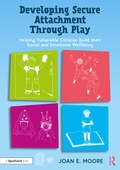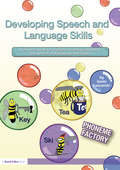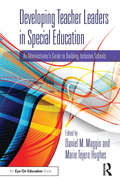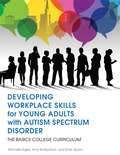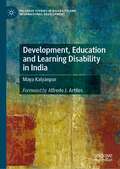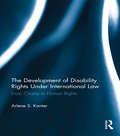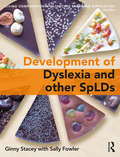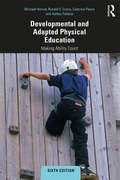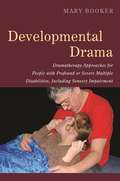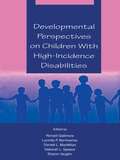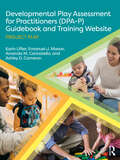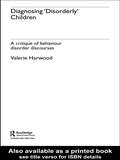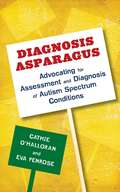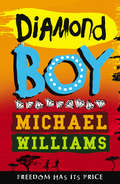- Table View
- List View
Developing Secure Attachment Through Play: Helping Vulnerable Children Build their Social and Emotional Wellbeing
by Joan E. MooreDeveloping Secure Attachment Through Play offers a range of imaginative and engaging play-based activities, designed to help vulnerable young children forge safe attachments with their caregivers. The book focuses on key developmental stages that may have been missed due to challenging life circumstances, such as social-emotional development, object permanence and physical and sensory development. It also considers pertinent issues including trauma, separation, loss and transition. Chapters explore each topic from a theoretical perspective, before offering case studies that illustrate the theory in practice, and a range of activities to demonstrate the effectiveness of play in developing healthy attachments. Key features of this book include: • 80 activities that can be carried out at home or in educational settings, designed to facilitate attachment and enhance social-emotional development; • case vignettes exploring creative activities such as mirroring, construction play, physical play, baby doll play and messy play; • scripts and strategies to create a safe and respectful environment for vulnerable children; • photocopiable and downloadable resources, including early learning goals, a collection of therapeutic stories and a transition calendar By engaging children in these activities, parents, caregivers and practitioners can help the children in their care gain a sense of belonging and develop their self-esteem. This will be a valuable resource for early years practitioners, adoptive, foster and kinship parents, and therapists and social workers supporting young children.
Developing Secure Attachment Through Play: Helping Vulnerable Children Build their Social and Emotional Wellbeing
by Joan E. MooreDeveloping Secure Attachment Through Play offers a range of imaginative and engaging play-based activities, designed to help vulnerable young children forge safe attachments with their caregivers. The book focuses on key developmental stages that may have been missed due to challenging life circumstances, such as social-emotional development, object permanence and physical and sensory development. It also considers pertinent issues including trauma, separation, loss and transition. Chapters explore each topic from a theoretical perspective, before offering case studies that illustrate the theory in practice, and a range of activities to demonstrate the effectiveness of play in developing healthy attachments. Key features of this book include: • 80 activities that can be carried out at home or in educational settings, designed to facilitate attachment and enhance social-emotional development; • case vignettes exploring creative activities such as mirroring, construction play, physical play, baby doll play and messy play; • scripts and strategies to create a safe and respectful environment for vulnerable children; • photocopiable and downloadable resources, including early learning goals, a collection of therapeutic stories and a transition calendar By engaging children in these activities, parents, caregivers and practitioners can help the children in their care gain a sense of belonging and develop their self-esteem. This will be a valuable resource for early years practitioners, adoptive, foster and kinship parents, and therapists and social workers supporting young children.
Developing Speech and Language Skills: Phoneme Factory
by Gwen LancasterThis book is part of the Phoneme Factory Project undertaken by Granada Learning in partnership with the Speech and Language Therapy Research Unit (SLTRU) in Bristol. It aims to provide guidance for teachers, SENCos, SLTs and parents regarding: criteria for referral to speech and language therapy phonological disorders appropriate intervention approaches that can be used in the classroom and at home. Complementing the book is a CD containing downloadable resources including a picture library for the classroom and the home, as well as checklists and other time-saving documents.
Developing Speech and Language Skills: Phoneme Factory
by Gwen LancasterThis book is part of the Phoneme Factory Project undertaken by Granada Learning in partnership with the Speech and Language Therapy Research Unit (SLTRU) in Bristol. It aims to provide guidance for teachers, SENCos, SLTs and parents regarding: criteria for referral to speech and language therapy phonological disorders appropriate intervention approaches that can be used in the classroom and at home. Complementing the book is a CD containing downloadable resources including a picture library for the classroom and the home, as well as checklists and other time-saving documents.
Developing Teacher Leaders in Special Education: An Administrator’s Guide to Building Inclusive Schools
by Daniel M. Maggin Marie Tejero HughesPractical and forward-thinking, Developing Teacher Leaders in Special Education is the administrator's essential guide to growing special educator leadership in any school, district, or program. Special educators need to be flexible, proactive, and collaborative – qualities that make them uniquely suited to roles in school leadership – but these skills are often overlooked when choosing effective teacher leaders. Featuring helpful tips and detailed examples to demonstrate the concepts in action, this book breaks down the qualities that special educators can bring to your school leadership team and explores how you can leverage those skills to create a more inclusive and successful community.
Developing Teacher Leaders in Special Education: An Administrator’s Guide to Building Inclusive Schools
by Daniel M. Maggin Marie Tejero HughesPractical and forward-thinking, Developing Teacher Leaders in Special Education is the administrator's essential guide to growing special educator leadership in any school, district, or program. Special educators need to be flexible, proactive, and collaborative – qualities that make them uniquely suited to roles in school leadership – but these skills are often overlooked when choosing effective teacher leaders. Featuring helpful tips and detailed examples to demonstrate the concepts in action, this book breaks down the qualities that special educators can bring to your school leadership team and explores how you can leverage those skills to create a more inclusive and successful community.
Developing Workplace Skills for Young Adults with Autism Spectrum Disorder: The BASICS College Curriculum (PDF)
by Amy Rutherford Emily Quinn Michelle RiglerThe BASICS College Curriculum presents a hands-on approach to learning essential independence and life skills for students and new graduates with Autism Spectrum Disorder (ASD). The fourth book helps young adults to develop strategies for successfully managing workplace challenges, both before they enter the workplace and during employment. Students or recent graduates are shown how to identify and develop strategies to overcome common challenges associated with ASD in the workplace. These include communication and social interactions with colleagues, working in a team, proactively and successfully managing workload, dealing with stress, and managing their emotions. Ideal for graduates to use independently or for students in their last year of college, each chapter has a lesson-based progressive structure, providing valuable information and advice for the student, useful diagrams, practical exercises and workbook components that can be filled in at home or in class. Self-assessment tools ensure the skills from each chapter can be reviewed and adjusted as necessary. The book can be used on its own or in conjunction with the other books in the BASICS curriculum for a complete program of self-development.
Development, Education and Learning Disability in India (Palgrave Studies in Disability and International Development)
by Maya KalyanpurThis book uses qualitative research methods to examine why students in an Indian context are being identified as having learning disabilities on criteria that are largely drawn from the context of the Global North. It explores the push towards English language instruction as a possible factor that affects poor academic outcomes for students from low-income backgrounds who may be first-generation learners or English language learners. The book contrasts the different outcomes and supports for academically struggling students across low-income and middle-income backgrounds, with evidence to suggest that, despite the inclusionary principles of Education For All, this label is creating a marginalized group of students.
The Development of Disability Rights Under International Law: From Charity to Human Rights
by Arlene S. KanterThe adoption of the Convention on the Rights of People with Disabilities (CPRD) by the United Nations in 2006 is the first comprehensive and binding treaty on the rights of people with disabilities. It establishes the right of people with disabilities to equality, dignity, autonomy, full participation, as well as the right to live in the community, and the right to supported decision-making and inclusive education. Prior to the CRPD, international law had provided only limited protections to people with disabilities. This book analyses the development of disability rights as an international human rights movement. Focusing on the United States and countries in Asia, Africa, the Middle East the book examines the status of people with disabilities under international law prior to the adoption of the CPRD, and follows the development of human rights protections through the convention’s drafting process. Arlene Kanter argues that by including both new applications and entirely new approaches to human rights treaty enforcement, the CRPD is significant not only to people with disabilities but also to the general development of international human rights, by offering new human rights protections for all people. Taking a comparative perspective, the book explores how the success of the CRPD in achieving protections depends on the extent to which individual countries enforce domestic laws and policies, and the changing public attitudes towards people with disabilities. This book will be of excellent use and interest to researchers and students of human rights law, discrimination, and disability studies.
The Development of Disability Rights Under International Law: From Charity to Human Rights
by Arlene S. KanterThe adoption of the Convention on the Rights of People with Disabilities (CPRD) by the United Nations in 2006 is the first comprehensive and binding treaty on the rights of people with disabilities. It establishes the right of people with disabilities to equality, dignity, autonomy, full participation, as well as the right to live in the community, and the right to supported decision-making and inclusive education. Prior to the CRPD, international law had provided only limited protections to people with disabilities. This book analyses the development of disability rights as an international human rights movement. Focusing on the United States and countries in Asia, Africa, the Middle East the book examines the status of people with disabilities under international law prior to the adoption of the CPRD, and follows the development of human rights protections through the convention’s drafting process. Arlene Kanter argues that by including both new applications and entirely new approaches to human rights treaty enforcement, the CRPD is significant not only to people with disabilities but also to the general development of international human rights, by offering new human rights protections for all people. Taking a comparative perspective, the book explores how the success of the CRPD in achieving protections depends on the extent to which individual countries enforce domestic laws and policies, and the changing public attitudes towards people with disabilities. This book will be of excellent use and interest to researchers and students of human rights law, discrimination, and disability studies.
The Development of Dyslexia and other SpLDs
by Ginny Stacey Sally FowlerDevelopment of Dyslexia and Other SpLDs is about the persistence of dyslexia and specific learning difficulties (SpLD) into adulthood. It pulls together experiences of many dyslexic/SpLD people. The book is written with non-linear readers in mind: those who need to move about a book picking up ideas that are currently relevant to them; a style that suits many dyslexic/SpLD readers. The book gives a framework for understanding the wide-ranging experiences of dyslexic/SpLD adults. With the greater understanding, there should be better help for: • adults who still have no strategies for dealing with dyslexic/ SpLD problems • children who have some skills but not at the level of their overall intelligence • young children who show the first signs of difficulties • dyslexic/SpLD children in mainstream schools. A new paradigm is proposed whereby all teaching programmes utilise each learner’s learning strengths - catering for dyslexic and SpLD adults and children involves vital teaching and learning approaches that are good practice for all.
Developmental and Adapted Physical Education: Making Ability Count
by Michael Horvat Ronald V. Croce Caterina Pesce Ashley Eason FallaizeNow in a fully revised and updated 6th edition, reflecting changes in legislation and cutting-edge research, this is a complete introduction to adapted physical education, from the underpinning science to practical teaching strategies and program design. The book covers a broader range of disabilities, developmental disorders, and health conditions than any other textbook and includes brand new material on developmental coordination disorders and cognitive development. Full of teaching and coaching strategies and techniques, it introduces scientific fundamentals, key legislation, and best practice in designing effective programs. It encourages the reader to consider the individual before the disability and to focus on what learners can do rather than what they can’t. This is an essential reference for teachers, coaches, or exercise professionals working with children with disabilities. It is also an invaluable resource for undergraduate or postgraduate students of adapted physical education, kinesiology, physical education, physical therapy, exercise science, athletic training, or sports coaching. The new edition features updated online resources, including PowerPoint slides, web links, an example syllabus, and quizzes.
Developmental and Adapted Physical Education: Making Ability Count
by Michael Horvat Ronald V. Croce Caterina Pesce Ashley Eason FallaizeNow in a fully revised and updated 6th edition, reflecting changes in legislation and cutting-edge research, this is a complete introduction to adapted physical education, from the underpinning science to practical teaching strategies and program design. The book covers a broader range of disabilities, developmental disorders, and health conditions than any other textbook and includes brand new material on developmental coordination disorders and cognitive development. Full of teaching and coaching strategies and techniques, it introduces scientific fundamentals, key legislation, and best practice in designing effective programs. It encourages the reader to consider the individual before the disability and to focus on what learners can do rather than what they can’t. This is an essential reference for teachers, coaches, or exercise professionals working with children with disabilities. It is also an invaluable resource for undergraduate or postgraduate students of adapted physical education, kinesiology, physical education, physical therapy, exercise science, athletic training, or sports coaching. The new edition features updated online resources, including PowerPoint slides, web links, an example syllabus, and quizzes.
Developmental And Adapted Physical Education (PDF)
by H. Clarke David ClarkeThis comprehensive book on developmental and adapted physical education is intended for physical educators in schools and colleges, although applications to physical reconditioning and corrective therapy in hospitals and rehabilitation centers can readily be made.
Developmental Drama: Dramatherapy Approaches for People with Profound or Severe Multiple Disabilities, Including Sensory Impairment
by Mary Adelaide BookerPeople living with severe or profound multiple disabilities (PMLD) can often struggle to connect with the world around them. This book shows how, through enjoying dramatic interaction, they can develop their communication skills, learn to deal with emotions more effectively and gain a greater understanding of their physical and social environment. This guide presents a variety of ways in which drama can be used as a medium for assisting the social and emotional development of people with PMLD, including sensory impairment. It fully explains techniques that are proven to build confidence and promote participation, and illustrates how to include support staff effectively within the process. Charting the author's own journey as a dramatherapist, it clarifies in detail some effective approaches and how to address key issues that arise in dramatherapy practice. This is an accessible and life-saving guide for practitioners looking to use drama in work with people with PMLD, but are unsure where to begin.
Developmental Drama: Dramatherapy Approaches for People with Profound or Severe Multiple Disabilities, Including Sensory Impairment (PDF)
by Mary Adelaide BookerPeople living with severe or profound multiple disabilities (PMLD) can often struggle to connect with the world around them. This book shows how, through enjoying dramatic interaction, they can develop their communication skills, learn to deal with emotions more effectively and gain a greater understanding of their physical and social environment. This guide presents a variety of ways in which drama can be used as a medium for assisting the social and emotional development of people with PMLD, including sensory impairment. It fully explains techniques that are proven to build confidence and promote participation, and illustrates how to include support staff effectively within the process. Charting the author's own journey as a dramatherapist, it clarifies in detail some effective approaches and how to address key issues that arise in dramatherapy practice. This is an accessible and life-saving guide for practitioners looking to use drama in work with people with PMLD, but are unsure where to begin.
Developmental Perspectives on Children With High-incidence Disabilities (The LEA Series on Special Education and Disability)
by Ronald Gallimore Lucinda P. Bernheimer Donald L. MacMillan Deborah L. Speece Sharon VaughnThis volume has two purposes. The first is to summarize, substantiate, and extend current knowledge on the development of children with high incidence disabilities--most notably, learning disabilities, behavioral disorders, and mild mental retardation. The second is to honor the career of Professor Barbara K. Keogh and her contributions to the developmental study of children with high incidence disabilities. Internationally recognized for her accomplishments, Keogh is esteemed for her originality and clarity of thought. For nearly forty years, she has set an extraordinary model of analytic rigor combined with a kind and generous manner that inspires, supports, and sets an exacting standard of scholarship. The contributing authors to this volume represent only a fraction of the students and scholars touched by her distinguished career. In conceiving this volume, the editors sought to represent the topics, problems, and issues to which Keogh has devoted herself. They invited chapters that summarize what is known about the high incidence handicapping conditions that her research has mainly addressed and sought to reflect the probing, questioning style that she brings to her own work. Researchers, policymakers, and graduate students in special education and associated disciplines who seek to stay current will find this volume crucial reading.
Developmental Perspectives on Children With High-incidence Disabilities (The LEA Series on Special Education and Disability)
by Ronald Gallimore Lucinda P. Bernheimer Donald L. MacMillan Deborah L. Speece Sharon R. VaughnThis volume has two purposes. The first is to summarize, substantiate, and extend current knowledge on the development of children with high incidence disabilities--most notably, learning disabilities, behavioral disorders, and mild mental retardation. The second is to honor the career of Professor Barbara K. Keogh and her contributions to the developmental study of children with high incidence disabilities. Internationally recognized for her accomplishments, Keogh is esteemed for her originality and clarity of thought. For nearly forty years, she has set an extraordinary model of analytic rigor combined with a kind and generous manner that inspires, supports, and sets an exacting standard of scholarship. The contributing authors to this volume represent only a fraction of the students and scholars touched by her distinguished career. In conceiving this volume, the editors sought to represent the topics, problems, and issues to which Keogh has devoted herself. They invited chapters that summarize what is known about the high incidence handicapping conditions that her research has mainly addressed and sought to reflect the probing, questioning style that she brings to her own work. Researchers, policymakers, and graduate students in special education and associated disciplines who seek to stay current will find this volume crucial reading.
Developmental Play Assessment for Practitioners (DPA-P) Guidebook and Training Website: Project Play
by Karin Lifter Emanuel J. Mason Amanda M. Cannarella Ashley D. CameronDevelopmental Play Assessment for Practitioners (DPA-P) Guidebook and Training Website: Project Play offers a comprehensive assessment of naturally occurring play activities for evaluating young children’s developmental progress accurately, so that useful interventions can take place as early as possible. It can be used by practitioners in a wide range of educational and therapeutic settings and is designed to support developmental progress through planning interventions in play, and using what we know about a child’s progress in play to plan play-based interventions in cognition, language, motor, social-emotional, and self-help skills. The guidebook and training website provide a comprehensive introduction to how to successfully use the assessment with infants, toddlers, and young children with disabilities or at risk for disabilities. The comprehensive guidebook offers an overview of the DPA-P and Project Play, defines play, discusses the background literature on play, and explains why this assessment is needed. Clear guidance helps practitioners and family members understand play, how to evaluate play, and how to use play for different purposes. The guidebook offers: an introduction to the comprehensive training website and how to use it understanding of the categories of play assessed and their definitions guidance on how to administer the assessment and prepare a summary evaluation of a child’s performance clear instructions for the coding sheets and scoring guidelines for constructing sets of toys guidance on taking the results of the DPA-P evaluation of a child’s progress in play to develop a plan of activities for intervention explanation of how you evaluate activities at the absence, basic, emergence, and mastery levels for developing a plan suggestions for assembling sets of toys for intervention, based on toys available in children’s homes and early childhood settings procedures for facilitating or teaching play activities to children who are developing more slowly than their peers technical aspects of the assessment To make the DPA-P as flexible as possible for all practitioners, it also offers guidance on adaptations for administering the test, in the coding sheets, with toys to enhance cultural appropriateness for gathering the observations, and for supporting interventions in play. The Developmental Play Assessment for Practitioners (DPA-P) can be used in natural settings and takes 30 minutes to complete. It is a valuable tool for all those who serve, or are training to serve, young children in early childhood settings, schools, service agencies, colleges, and universities. It will be of great benefit for early intervention personnel, speech-language pathologists, physical therapists, occupational therapists, and psychologists.
Developmental Play Assessment for Practitioners (DPA-P) Guidebook and Training Website: Project Play
by Karin Lifter Emanuel J. Mason Amanda M. Cannarella Ashley D. CameronDevelopmental Play Assessment for Practitioners (DPA-P) Guidebook and Training Website: Project Play offers a comprehensive assessment of naturally occurring play activities for evaluating young children’s developmental progress accurately, so that useful interventions can take place as early as possible. It can be used by practitioners in a wide range of educational and therapeutic settings and is designed to support developmental progress through planning interventions in play, and using what we know about a child’s progress in play to plan play-based interventions in cognition, language, motor, social-emotional, and self-help skills. The guidebook and training website provide a comprehensive introduction to how to successfully use the assessment with infants, toddlers, and young children with disabilities or at risk for disabilities. The comprehensive guidebook offers an overview of the DPA-P and Project Play, defines play, discusses the background literature on play, and explains why this assessment is needed. Clear guidance helps practitioners and family members understand play, how to evaluate play, and how to use play for different purposes. The guidebook offers: an introduction to the comprehensive training website and how to use it understanding of the categories of play assessed and their definitions guidance on how to administer the assessment and prepare a summary evaluation of a child’s performance clear instructions for the coding sheets and scoring guidelines for constructing sets of toys guidance on taking the results of the DPA-P evaluation of a child’s progress in play to develop a plan of activities for intervention explanation of how you evaluate activities at the absence, basic, emergence, and mastery levels for developing a plan suggestions for assembling sets of toys for intervention, based on toys available in children’s homes and early childhood settings procedures for facilitating or teaching play activities to children who are developing more slowly than their peers technical aspects of the assessment To make the DPA-P as flexible as possible for all practitioners, it also offers guidance on adaptations for administering the test, in the coding sheets, with toys to enhance cultural appropriateness for gathering the observations, and for supporting interventions in play. The Developmental Play Assessment for Practitioners (DPA-P) can be used in natural settings and takes 30 minutes to complete. It is a valuable tool for all those who serve, or are training to serve, young children in early childhood settings, schools, service agencies, colleges, and universities. It will be of great benefit for early intervention personnel, speech-language pathologists, physical therapists, occupational therapists, and psychologists.
Diagnosing 'Disorderly' Children: A critique of behaviour disorder discourses
by Valerie HarwoodBased on the author's in-depth research with children diagnosed with behavioural difficulties, this book provides a thorough critique of today's practices, examining: the traditional analyses of behavioural disorders and the making of disorderly children the influence of the 'expert knowledge' on behavioural disorders and its influence on schools, communities and new generations of teachers the effect of discourses of mental disorder on children and young people the increasing medicalisation of young children with drugs such as Ritalin. This book offers an innovative and accessible analysis of a critical issue facing schools and society today, using Foucaultian notions to pose critical questions of the practices that make children disorderly. Rich in case studies and interviews with children and young people, it will make fascinating reading for students, academics and researchers working in the field of education, inclusion, educational psychology, sociology and youth studies.
Diagnosing 'Disorderly' Children: A critique of behaviour disorder discourses
by Valerie HarwoodBased on the author's in-depth research with children diagnosed with behavioural difficulties, this book provides a thorough critique of today's practices, examining: the traditional analyses of behavioural disorders and the making of disorderly children the influence of the 'expert knowledge' on behavioural disorders and its influence on schools, communities and new generations of teachers the effect of discourses of mental disorder on children and young people the increasing medicalisation of young children with drugs such as Ritalin. This book offers an innovative and accessible analysis of a critical issue facing schools and society today, using Foucaultian notions to pose critical questions of the practices that make children disorderly. Rich in case studies and interviews with children and young people, it will make fascinating reading for students, academics and researchers working in the field of education, inclusion, educational psychology, sociology and youth studies.
Diagnosis Asparagus: Advocating for Assessment and Diagnosis of Autism Spectrum Conditions (PDF)
by Catherine O'Halloran Eva PenroseA highly readable, insightful and sometimes humorous account of autism assessment, diagnosis and life with a 'label'. Eva was diagnosed with Asperger Syndrome (ASD) at age 11 and is now a fun-loving, sociable 16-year-old. This book, co-written with her mother, a speech and language therapist, discusses their reasons for seeking a diagnosis, the process of being assessed, their reactions to the news and the impact it has had on Eva's life. It also considers how diagnosis has helped them find strategies to lessen the challenges of living with an ASD. Concluding that it doesn't really matter whether the name for the set of traits that characterise autism changes or what it changes to, this life-affirming book shows diagnosis to be a positive and empowering experience. It will be helpful to any family embarking on the assessment process as well as professionals looking for insight into a family's diagnosis journey.
Diagnosis Asparagus: Advocating for Assessment and Diagnosis of Autism Spectrum Conditions
by Eva Penrose Catherine O'HalloranA highly readable, insightful and sometimes humorous account of autism assessment, diagnosis and life with a 'label'. Eva was diagnosed with Asperger Syndrome (ASD) at age 11 and is now a fun-loving, sociable 16-year-old. This book, co-written with her mother, a speech and language therapist, discusses their reasons for seeking a diagnosis, the process of being assessed, their reactions to the news and the impact it has had on Eva's life. It also considers how diagnosis has helped them find strategies to lessen the challenges of living with an ASD. Concluding that it doesn't really matter whether the name for the set of traits that characterise autism changes or what it changes to, this life-affirming book shows diagnosis to be a positive and empowering experience. It will be helpful to any family embarking on the assessment process as well as professionals looking for insight into a family's diagnosis journey.
Diamond Boy
by Michael Williams'Diamonds for everyone.' That's what fifteen-year-old Patson Moyo hears when his family arrives in the Marange diamond fields, leaving his previous life, school and friends behind with hopes for a better life. Soon Patson is working in the mines along with four friends in the Gwejana Syndicate – teen diamond miners, secretly pooling their profits and hoping to find the priceless stone that will change everything. But when the government's soldiers come to Marange, Patson's world is shattered. Set against the backdrop of President Mugabe's brutal regime in Zimbabwe, this is the story of a young man who succumbs to greed, but finds his way out through a transformative journey to South Africa in search of his missing sister, in search of freedom, and in search of himself.
